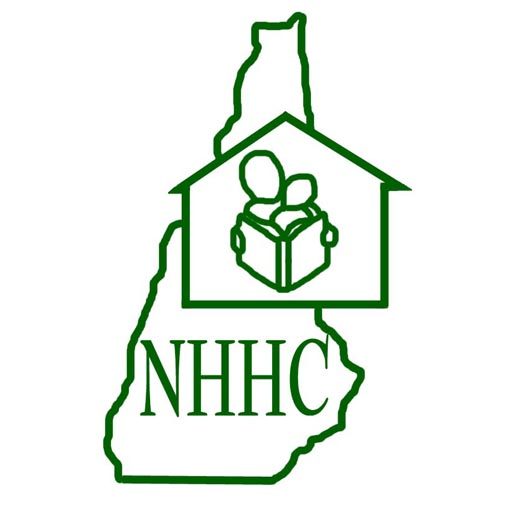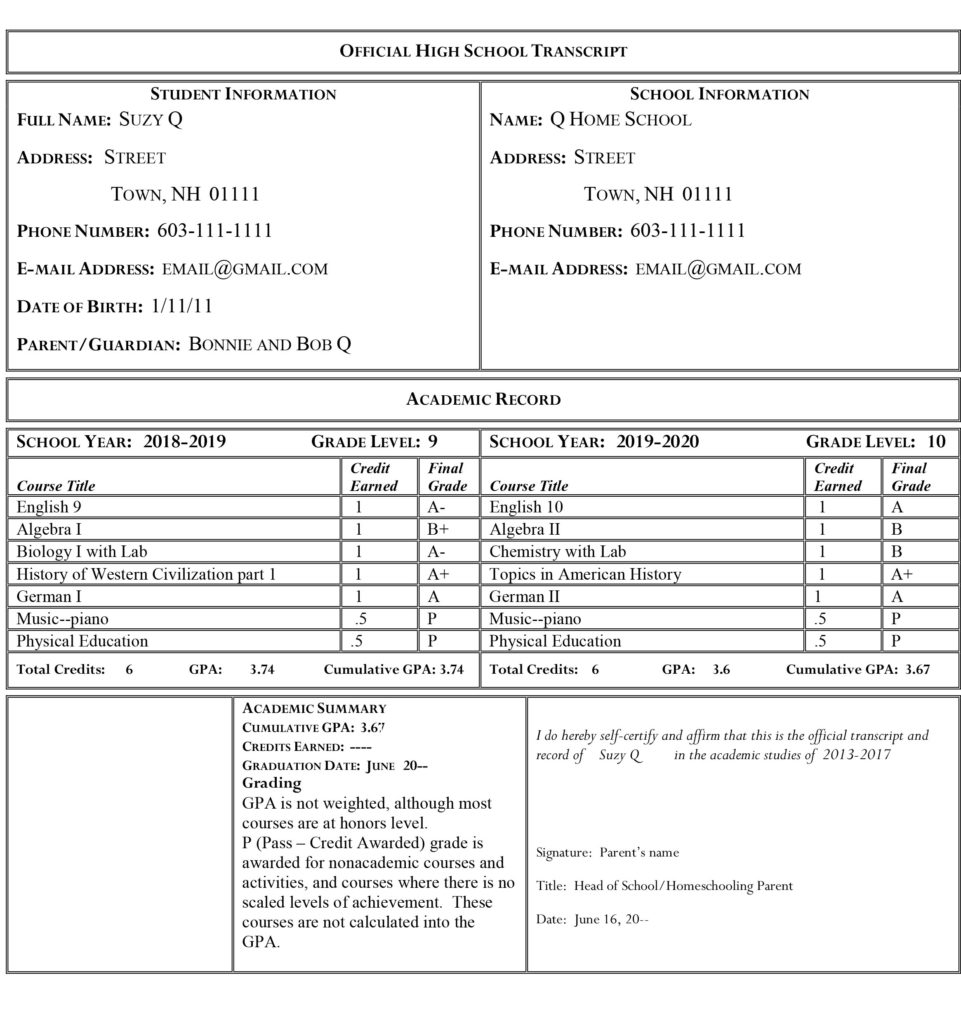Home Education Through High School
The first concern parents usually have is how to tackle the tough subjects. There is a wealth of homeschooling materials and programs available for teaching everything from chemistry to Italian. Homeschoolers frequently get together for lab courses in such subjects as biology and chemistry, and for foreign language classes with an experienced parent or tutor leading the class.
Homeschoolers can take classes at their local high school, see the equal access law. There are online schools that allow students to take single courses, or a complete high school curriculum. The Community College System of New Hampshire is very welcoming to homeschooled students and allows students to take courses in a variety of subjects. Some of these credits will transfer directly to the University of New Hampshire, Plymouth State, or Keene State.
As you start planning a high school course of study with your student, it’s important to consider what your student wants to do after high school. If college is in the plans, take a look at the admission requirements at the type of school your child is interested in. If they are looking at a particular career path, see what courses might be available in your area or online.
We all know people learn what they are interested in. Students can become experts in subject areas simply by doing and studying what they love. Don’t feel that all subjects need to be covered in a formal class. If a student needs “proof of competency” for application to college, they can do some test prep with study books and take AP tests or CLEP tests to show that they have learned the material.
As far as graduation and diplomas go, New Hampshire is a “self-certifying” state. That is, our state laws do not allow the state to certify homeschoolers work and New Hampshire does not give out state issued diplomas. If you are filling in financial aid forms for college, you can read more about this in the Applying to College area below and use the sample Self-Certification of Secondary School Completion.
Watch Our Videos on Homeschooling Through High School
Our workshop with a group of parents about how they covered high school work at home, in group classes, online, and at community college. The second half of the workshop focused on preparing transcripts for college applications and entering the workforce.
Homeschooling Through High School workshop – Part 1 high school options, resources, and experiences
Homeschooling Through High School – Part 2(video section 1): transcripts, applying to college, and sharing records to employers
Homeschooling Through High School – Part 2(video section 2): transcripts, applying to college, and sharing records to employers
Handouts from Homeschooling Through High School workshop July 24 , 2019
Teen Activities
Many support groups have teen activities, including game nights, Frisbee gatherings, movie nights, and even Proms. Take a look at the support group listings and get involved in a group. Sometimes a parent has to be the brave one to initiate regular meetings and activities for teens in their area. Groups come and go as homeschoolers graduate and their parents “retire” from running activities.
Finishing High School Before Age 18
You can certify completion for a student under the age of 18 who has finished high school by sending a letter to the Commissioner of Education. You can use the format in this sample. Otherwise the requirements of the homeschooling law must be met until the student turns 18.
Youth Employment Requirements
If your child aged 12-15 plans to work (many volunteer placements have this requirement too) they will need a Youth Employment Certificate. Here’s the process:
The child gets an Employer Request for Child Labor from their prospective employer.
Then the parent or guardian can issue the Youth Employment Certificate, (or they can have it issued at the local school department).
Youth age 16 and 17 do not require an Employment Certificate, and may perform any job which is not disallowed, but they must submit a Parental Permission Form. View the various Department of Labor forms here.
Anyone under age 18 is subject to restricted work hours, and may not work during the public school day regardless of their method of schooling unless they have graduated high school.
Some programs of Special Interest to New Hampshire Homeschoolers
Dual Credit for High School and College
eStart is a collaboration between the Community College System of New Hampshire (CCSNH) and the Virtual Learning Academy Charter School (VLACS). Students must be at least 15 years old to be eligible.
Earn high school and college credits for the same CCSNH 100% online course.
Pay $150 for CCSNH tuition plus the cost of a textbook. (save on college costs) Access the course from any Internet connection. Students work at their own pace to accomplish specific weekly assignments. Use the rich resources of the Web with a college instructor facilitating and encouraging a high level of student-to-student and student-to-faculty interaction.
http://www.ccsnh.edu/estart/
STEM Scholarship Program:
Funding is available for students (juniors/seniors) to take up to 2 STEM courses (science, technology, engineering and math) per year, and be fully reimbursed the eStart tuition cost. Students in designated STEM and STEM related courses can be reimbursed for these eStart courses after successful completion of the course by obtaining a C or better for a final grade. Reimbursements will occur after final grades are verified.
Applying to College
Applying to college, preparing transcripts and course descriptions, gathering recommendations, writing guidance counselor reports and school profiles.
College Planning
At the beginning of the high school years, you and your student should take a look at some of the requirements for application to the types of colleges your student is interested in. Do they need 3 or 4 years of math? What level? Is foreign language study required? How many years? Do you need science courses with labs? Will you need to submit lab reports?
You want to tentatively plan, and then be very flexible and adjust the plan accordingly. Your student might have wanted to study computer programming, but now needs to prepare a portfolio for art school. They might have planned to get a commercial driver license, but now want to get HVAC certification at a community college. What you don’t want to have is a situation where your child says, I want to do such and such, but I can’t because I don’t have this course work or music training, or whatever. Keep looking ahead to all of the options and possibilities.
Applying to College
Most colleges have a separate page on their website that specifies requirements for homeschooled applicants.

Let’s take a look at the materials you’ll need to have ready.
Transcripts and Course Descriptions
Transcripts are the list of courses, grades, and often course credits of a student. Some are arranged by year, some by subject area. You can easily make your own good looking transcript using table formats on Word, Google Drive, and other programs, and there are many templates out there online. Usually a GPA (grade point average) is calculated for each year and for the student’s work up to the current semester.

Sample transcript 9th and 10th grades
Here is part of a transcript made from a template on the HSLDA (Home School Legal Defense Association) website. You see that the major courses are listed and worth one credit each. Less demanding coursework, music lessons, phys.ed., are listed as being worth .5 credit and graded as pass/fail. Grades of A, B, C etc. can be turned into numeric grades on the standard scale,
A 4.0
A- 3.7
B+ 3.3
B 3.0
B- 2.7
C+ 2.3
C 2.0
C- 1.7
D+ 1.3
D 1.0
D- 0.7
F 0.0
Some high schools “weight” the transcript; that is, honors or AP (advanced placement) classes are given a higher numeric grade. Instead of A =4.0, an A = 4.5 or 5.0. This can be too complicated for a homeschool transcript; the scale must be noted, and honestly, the grades given by parents will always be examined critically. Colleges will be looking for confirmation of the grades via test scores and courses taken outside the home. And they will be looking at the level of the coursework in the course description.
In our sample transcript, under grade 9, we have an A-, B+, A-, A+, and A. (Pass/fail grades don’t count). These grades become 3.7, 3.3, 3.7, 4.0, and 4.0. Add the numbers and divide by 5 (five courses, five credits) to get an average of 3.74. If some courses are worth more credits than others, you would need to multiply each of the grades by the number of credits for that class. The cumulative GPA, listed at the bottom of the transcript, will be the average of all of the years/credits together.
The school will provide a transcript for any courses taken online, at the local high school, or community college. That transcript will need to be submitted to the college directly by the school, but you CAN use the grades in your transcript, so that the transcript shows the complete list of courses taken each year. Just put a little mark, maybe an asterisk *, and add a note at the bottom of the transcript, saying something like “course taken through VLACS.”
Course Descriptions
The transcript itself, if it’s just the name of a class and a grade, doesn’t mean much. That’s why colleges like to have an attached course description. It can be as simple as the name of the textbook and the topics covered in it, or it can be a more detailed list of books read, projects, and field trips.
An example of a course description made from a student’s personal interest and study:
Astronomy
Course consisted of self-study of aspects of astronomy including lunar geography, the planets, asteroids, meteors and comets, use of binoculars and telescopes, telescope optics and physical limitations, the sun, major deep sky objects, stars and their spectra, and orbits. Extensive time was spent in actual observation of the night sky using binoculars and a 4.5’’ equilateral Newtonian reflector telescope. Texts: Seeing the Sky, Fred Schaaf; Stargazing with Binoculars and Telescopes, John Mosley; Stars and their Spectra, James B. Kaler; Hubble’s Universe, Simon Goodwin; Turn left at Orion, Guy Consolmagno and Dan M. Davis; Skywatching, David Levy; Comets, David Levy; The Hatfield Photographic Lunar Atlas, Jeremy Cook; Secrets of the Night Sky, Bob Berman.; Jet Propulsion Laboratory https://www.jpl.nasa.gov/edu/; NASA www.nasa.gov; Sky and Telescope www.skyandtelescope.com.
An example of a course description derived from the description of the text in the publisher’s catalog.
Algebra II
In addition to covering topics of second year algebra, this course covered a considerable amount of geometry. Specific algebra topics covered included: graphical solution to simultaneous equations, scientific notation, radicals , roots of quadratic equations including complex roots, properties of the real numbers, inequalities and systems of inequalities, logarithms and antilogarithms, exponential equations, basic trigonometric functions, algebra of polynomials, vectors, polar and rectangular coordinate systems, and a wide spectrum of work problems. Time was spent developing geometric concepts and writing proof outlines. Set theory, probability and statistics were also treated. Text: Algebra 2, John Saxon.
An example of a course description from a teen activity
Literature Discussion Group
This monthly group provides an opportunity for homeschooled teens to give their impressions and discuss themes in some classic books on high school and college book lists. Titles selected include Brave New World, Their Eyes Were Watching God, Sense and Sensibility, The House of the Seven Gables, The Importance of Being Earnest, Frankenstein, Cry the Beloved Country and the short stories: “The Death Disk”, Mark Twain; “The Cask of Amontillado”, Edgar Allan Poe; “The Lady and the Tiger”, Frank R. Stockton; and “The Patented Gate and the Mean Hamburger”, Robert Penn Warren. Students enjoy socializing and exchanging ideas over refreshments.
Testing
College admission counselors know the standards at specific high schools all over the country. Because they can’t really tell the level of work a homeschooled student has been doing at home, most colleges rely on test scores to give them a sense of where a homeschooled student stands academically. (But academics aren’t the only thing they’re looking at, activities, essays, employment, etc. count too.) Even colleges that do not require SAT or ACT scores, usually do require them from homeschooled applicants.
The SAT (used more by colleges in the East and West Coast) and the ACT (used more in the Midwest) are the standard aptitude tests required. There is an alternative college entrance exam, the Classic Learning Test (CLT), accepted by 250+ colleges at present (updated August 2023), that can be taken online and at home in just 2 hours, gives results and analytics within 8 business days, and tests foundational education skills.
If you use testing for your annual evaluation for a few years, your student will have a sense of how it works. Still using test prep materials is a necessary part of getting a good score. Books are usually available at your local library or can be purchased, and practice materials are online at Kahn Academy and the College Board. Your child needs to be familiar with the test format, the style of questions, and how much time they will have. Doing practice tests is a great way to get ready and to give your student a sense of the level of college they are qualified for.
One common schedule is for a student to take the SAT, or ACT, in the spring of their junior year. Then the student can repeat the test in the fall of their senior year. Their scores inevitably go up because they are less nervous, have matured a bit, and have learned more.
Tests in Specific Subjects
Many of the more competitive colleges used to ask for scores from SAT subject tests, often one score in a math or science, and one score in a language arts or social studies area. SAT subject are being discontinued by the College Board and we’re not sure if there will be any substitute. Students can take AP (advanced placement) courses in co-ops, online, and at schools or you can teach AP level material at home. BUT the teacher and student must sign up for the spring AP exam in that course (exams given at the local school) in the fall. Up-to-date info at https://apcentral.collegeboard.org/
CLEP tests allow a student to receive college credit in a variety of subjects. Credits are accepted by many colleges, but not all. Modern States is a non-profit organization that provides free and low cost college courses, allowing students to bypass the freshman year at some colleges. They will now pay the fee for students to take CLEP exams to place out of classes (at some colleges) https://modernstates.org/
Scholarship and Financial Aid Assistance
The NHHEAF Network Organizations are the largest source for college funding within New Hampshire and have a more than 40-year history of helping families plan for and fund higher education.
Diplomas and Self-certification of Completion of High School and its connection to Financial Aid
You should know that colleges are not allowed to ask that the student take a GED to be accepted to receive financial aid. They are often confused about this! Refer them to the “Dear Colleague letter”. Among other things in this letter from the U.S. Department of Education is the statement:”With regard to documenting a home-schooled student’s completion of secondary school in a home-schooled setting, an institution may accept a home-schooled student’s self-certification that he or she completed secondary school in a home school setting, just as it may accept a high school graduate’s self-certification of his or her receipt of a high school diploma.”
Sample Self-Certification of Secondary School Completion
Confusion at College Admissions Offices about Certification of High School Completion
We are hearing of colleges asking that homeschooled students submit a state or school district issued high school graduation credential, a certificate of completion from the local school district or state board of education, or proof that they have met the requirements of their state for graduation for homeschool students with their application. Colleges may set any admission requirements they like, but they usually set the requirements for homeschooled students with federal student aid guidelines in mind. They want to make sure all students will be able to comply if need be.
Because of recent changes in the Federal Student Aid handbook, college admissions offices have gotten confused between states that do issue such credentials and states that do not. There are no specific requirements for graduation for homeschoolers in New Hampshire and New Hampshire issues no high school completion credential. New Hampshire homeschoolers “self-certify.” Sample Self-Certification of Secondary School Completion
The New Hampshire Department of Education has placed an explanation on their website here. You may find it helpful to direct admissions officers to this page.
Other Places to Find Information
Do talk with your area NHHC representative if some of this is confusing. If the representative doesn’t have a lot of experience with college applications, they will put you in touch with a NHHC Board member who does. We have an active Board of homeschoolers with a wide range of experience.
